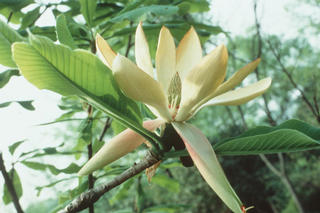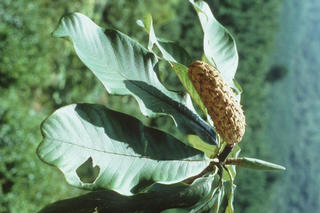Magnolia officinalis
Contents
Nomenclature
Other Names:
Historical Use of Magnolia officinalis
Magnolia officinalis in Traditional Chinese Medicine
Background
Chuanpo ´¨ÆÓ
Jianghoupo ½ªºñÆÓ
Zhichuanpo ÖÆ´¨ÆÓ
Chinese Name (pinyin): Houpo
Chinese Name :
Common Name :Magnolia Bark
Specific Name : Cortex magnoliae officinalis
Scientific Name:
Collection : The drug is collected from April to June. The root bark and the branch bark are dried in the shade. The stem bark is slightly decocted in boiled water and piled up in a wet place until its inner surface purplish-brown or brown, steamed to rolled and dried.
Description : Stem Bark: Quilled singly or double quilled, 30-35cm long, 2-7mm thick, commonly known as "Tongpo", one end near the root spread out like a bell, 13-25cm long, 3-8mm thick commonly known as "Xuetongpo". Outer surface greyish brown, rough, sometimes scaled, easily exfoliated, with distinct elliptical lenticels and longitudinal wrinkles, appearing yellowish brown when the coarse outer layer peeled, inner surface purplish brown or dark purplish brown relatively smooth with fine longitudinal striations and exhibiting oily traces on scratching. Texture hard, uneasily broken, fracture granular, greyish brown in outer layer and purplish brown or brown in the inner layer, oily sometimes numerous small bright spots visible. Odour aromatic, taste pungent and slightly bitter.Root bark (Genpo) : Quilled singly or pieced irregularly, some curved like chicken intestines commonly known as "Jichangpo", texture hard, easily broken, fracture fibrous.Branch bark (Zhipo): Quilled singly, 10-20cm long, 1-2mm thick, texture fragile, easily broken, fracture fibrous.
Identification : 1. Transverse section: Cork consisting of over 10 rows of cells, sometimes rhytidome found. The outer side of the cortex showing a ring of stone cells and the inner scattered with numerous oil cells and groups of stone cells wide. Fibres mostly several in bundles, oil cells scattered.Powder: Brown, fibres numerous, 15-32µm in diameter, walls strongly thickened, sometimes undulate or serrate at one side, lignified, pit canals indistinct. Stone cells subsquare,elliptical, ovate or irregular branched, 11-65µm in diameter, sometimes striation visible. Oil cells elliptical or subrounded, 50-85µm in diameter containing yellowish brown oily contents.3.To 0.5g of the powder, add 5ml of methanol, stopper well, shake for 30 minutes and filter. The filtrate used as the test solution. Dissolve magnolol CRS and honokiol CRS in methanol to produce a mixture containing 1mg of each per ml as the reference solution. Carry out the method for thin layer chromatopgraphy (Appendix Vl B) using silica gel G as the coating substance and benzene methanol (27:1) as the mobile phase. Apply separately to the plate 5µl of each of the two solutions. After developing and removal of the plate, dry it in the air and spray with 1% solution of vanillin in sulfuric acid, heat at 100ºC for about 10 minutes. The spots in the chromatogram obtained with the test solution correspond in position and colour to the spots in the chromatogram obtained with the reference solution.Assay: Magnolol reference preparation, dissolve magnolol CRS accurately weighed dried over phosporous pentoxide to constant weight in ethanol to produced 20µg per ml.Honokiol reference preparation: perform the procedure in the same manner as describe above.Test preparation: Weigh accurately about 1g of powder through sieve no.3, perform a determination of water (Appendix lX H) method 2, add accurately 25 ml of ethanol, heat under reflux for 1 hour, cool and filter. Discard the initial filtrate and collect the successive filtrate as the test solution.Procedure: Carry out the method of thin layer chromatography (Appendix Vl B) using silica gel GF254 as coating substance and benzene-methanol (9:1) as the mobile phase. Apply accurately in the strips separately to the plate 100µl of the test solution (the test solution of root bark should be previously diluted with ethanol to one half of its original concentration) and 5µl of the reference solution obtained under identification test (2) at a distance 0f 1.5cm apart. After developing and removal of the plate, dry it in the air and examine under ultra violet light (254nm). Scrape off separately the corresponding strips due to magnolol CRS, honokiol CRS and of an equal area of silica GF254 on the same plate as the blank, transfer to 10ml cetrifugal tubes respectively. Add accurately 10 ml of ethanol of each tube, stir for 10 minutes and cetrifuge. Carry out the method for spectrophotometry (Appendix V A) measure the absorbances of the supernatant of the test solution, reference solutions of magnolol and of honokiol at 294nm, calculate the contents of the magnolol and honokiol accordingly. It contains less than 3.0% of the total amount of magnolol (C18H18O2) and honokiol (C18H18O2) calculated on dried basis.
Processing : scrape off the coarse outer layer, wash clean, soften thoroughly, cut into slivers and dry in the sun. The slivers curved, fracture fibrous, outer surface yellowish-brown, inner surface dark purplish-brown.Processed with vinegar: Stir fry the slivers as described under the method for stir frying with ginger juice (Appendix ll D) to dryness. The slivers curved fracture fibrous, externally purplish-brown.
Action : To eliminate damp and relieve distension.
Indication : accumulation of damp in the spleen and the stomach marked by epigastric stuffiness, vomiting and diarrhea; abdominal distension and constipation due to retention of undigested food; cough and dyspnea caused by retained damp
Precautions :
Dosage : 3 to 9 g.
Storage : Preserve in a ventilated and dry place.
Nomenclature
Other Names:
Historical Use of Magnolia officinalis
Magnolia officinalis in Traditional Chinese Medicine
Background
Chinese Name (pinyin): Houpohua
Chinese Name :
Common Name :Officinal Magnolia Flower
Specific Name : Flos magnoliae ofiicinalis
Scientific Name:
Collection : The drug is collected in spring before flowering, steamed briefly and dried in the sun or at a low temperature.
Description : Long conical, 4-7cm long, 1.5-2.5cm in diameter at the base, reddish brown to brown, usually parianth segments 12, fleshy, the ones of outer whorl rectangular obovate, the ones of inner whorl spatulate, stamens numerous, anthers linear, yellowish brown, filaments broad and short. Carpels numerous, free, spirally aggregated on the conical receptacle. Pedicels 0.5-2cm long densely covered with greyish yellow tomenta. Texture fragile, breakable. Odour aromatic, taste weak.
Identification : 1.Powder: Reddish brown, epidermal cells of parianth-segments polygonal or elliptical, surface densely warty and some finely striated. Stone cells numerous, irrigularly branched with distinctly pitted walls, 7 - 13µm thick and large lumen. Oil cells subrounded or elliptical, 37 - 85µm in diameter, slightly thick walled, containing yellowish brown contents. Pollen grains elliptical, 48 - 68µm long. 37 - 48µm in diameter, anasulcate, exine with fine reticulate sculptures. Non-glandular hairs consisting of 1 - 3 cells, 820 - 2300 µm long, the walls heavily thickened, sometimes surface showing spiral cuticular striations, unicellular hairs acuminate at the apex, slightly inflated at the base, the basal cells of multicellular hairs relatively short or obviously inflated, thin walled.2.To 1g add 8ml of methanol, stopper tightly and shake for 30 minutes, filter, use the filtrate as the test solution. Dissolve magnolol CRS and honokiol CRS in methanol to produce a solution containing 1mg of each per ml as the reference solution. Carry out the method for thin layer in the chromatograghy (appendix Vl B) using silica gel G as the coating substance and benzene-methanol (27:1) as the mobile phase. Apply separately 5µl of each of the above two solutions to the plate. After developing and removal of the plate, dry it in the air, spray with 1% solution of vanillin in sulfuric acid, dry at 100ºC for about 10 minutes. The spot in the chromatogram obtained with the test solution corresponds in the colour and position to the spot in the chromatogram obtained with the reference solution.
Processing :
Action : To regulate the flow of qi and eliminate damp.
Indication : feeling of stuffiness and distension in the chest and epigastrium with loss of appetite
Precautions :
Dosage : 3 to 9 g.
Storage : Preserve in a dry place, protected from mould and moth.
Synonymns for Magnolia officinalis
Patent Medicines and Medicines with Multiple Ingredients that include Magnolia officinalis
Pharmaceutical Information
Chemical Constituents
Evidence or the Use of Magnolia officinalis in the Treatment of Epilepesy
Basic Science
Animal Studies
Cohort, Case-Control and Non-Randomized Trials
Randomized Controlled Trials
Meta-Analysis
1st Five Results: pubmed search
Laura B Oswald, Amanda Bloomer, Xiaoyin Li, Esther Jean-Baptiste, Gillian Trujillo, Seth Felder, Brent J Small, Jennifer Ose, Sheetal Hardikar, Ildiko Strehli, Lyen C Huang, Kathi Mooney, Matthew G Mutch, Dante Chao, Stacey A Cohen, Meghana Karchi, Elizabeth H Wood, Victoria Damerell, Nicole C Loroña, Jun Gong, Adetunji T Toriola, Christopher I Li, David Shibata, Martin Schneider, Biljana Gigic, Jane C Figueiredo, Heather S L Jim, Cornelia M Ulrich, Erin M Siegel
Functional quality of life among newly diagnosed young adult colorectal cancer survivors compared to older adults: results from the ColoCare Study.
Support Care Cancer: 2024, 32(5);298
[PubMed:38639810]
[WorldCat.org]
[DOI]
(I e)
Robert A Hauser, Aleksandar Videnovic, Patrício Soares-da-Silva, Grace S Liang, Kurt Olson, Eric Jen, José-Francisco Rocha, Olga Klepitskaya
OFF-times before, during, and after nighttime sleep periods in Parkinson's disease patients with motor fluctuations and the effects of opicapone: A post hoc analysis of diary data from BIPARK-1 and -2.
Parkinsonism Relat Disord: 2024, 123;106971
[PubMed:38631081]
[WorldCat.org]
[DOI]
(I a)
Lianxiang Luo, Tong Wu, Miaorong Ji, Jing Xiang, Youwen Zou, Yinglin Liao
Honokiol suppress the PD-L1 expression to improve anti-tumor immunity in lung cancer.
Int Immunopharmacol: 2024, 133;112098
[PubMed:38626551]
[WorldCat.org]
[DOI]
(I a)
Chutipa Kanjanapokin, Paitip Thiravetyan, Nattida Chonjoho, Rujira Dolphen, Chairat Treesubsuntorn
Light-emitting plants development by inoculating of Vibrio campbellii RMT1 on the rhizospheric zone of Aglaonema cochinchinense.
Photochem Photobiol Sci: 2024;
[PubMed:38622375]
[WorldCat.org]
[DOI]
(I a)
Carla D Zingariello, Dong-Hui Chen, Wendy H Raskind, William B Slayton, Sub Subramony, Joyce Severance, Megan Feagle, Sonja A Rasmussen
Assessing Long-Term Neurologic Outcomes in SAMD9L-Related Ataxia-Pancytopenia Syndrome.
Mov Disord Clin Pract: 2024;
[PubMed:38594844]
[WorldCat.org]
[DOI]
(I a)

